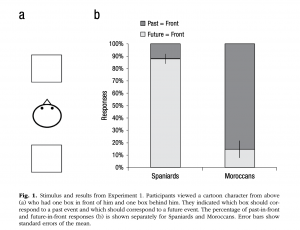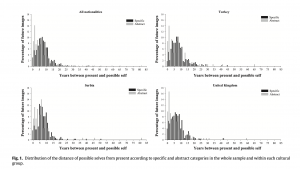Amongst all the reasons explaining why we are wrong about the futures, there is one that is deeply rooted in who we are as human beings: our culture. This leads to some interesting facts when we have to deal with future(s). Lets call them « biases » or at least prerequisites that we need to know and understand :
#1 : We spatialize the future differently : In an article written by De la Fuente & al in 2014, a team of researchers has made a fairly simple experiment. They presented a cartoon character viewed from above, and added two blank boxes. One in front of it, and one behind. They then asked Spaniard and Morrocans which box corresponded to a past event, and which one corresponded to a future event.
As detailed in the graph below, the results are fairly different : Spaniards puts the future in the front box, whereas Morrocans put the future in the box that is behind.

This test validated the authors’ hypothesis which is called the ” temporal-focus hypothesis “: the box in which we put the future is dependent upon the fact that our culture is a so-called ” past or future oriented” one. The key point here is that the verbal metaphors used between Morrocans and Spaniards are not that opposed, and that the metaphors used by Morrocans do not suggest that space-time representation issue. The authors conclude that “Cultural attitudes and practices can influence habits of attending to past or future events in members of a culture (or subculture), thereby influencing their implicit spatialization of time » A second order consequence is that we all have some implicit assumptions about not only what the future might be, but also about what is the future itself. Revealing these assumption is a necessary first step before any prospective exercice.
#2 : We imagine our future selves extremely differently
Quite a few studies have been written on how we see ourselves in the future. A cross-cultural one written by Rathbone & al explain how culturally situated our opinions of our future self is. In their study, they asked young adults from Serbia, Turkey and England to generate eight possible images of future selves. They then asked them to rank these possible images in terms of vividness, positivity, imagery perspective and wether they involved other people or not. Once the responses were given, they also coded them in order to check if they were abstract (not precise, emotional), or precise (for instance ” I will be a mother”).
One of the first findings is that there is a robust tendency for specific possible selves to be dated further from the present than abstract possible selves. It seems that it is easier to picture ourselves precisely in the longer term that in the short term. In terms of management this is interesting because, it is counterintuitive to what we usually think : the further away, the more difficult to situate one’s company. This might be true with respect to abstract concepts, for example what is called a “company”. Thus, it seems to be easier to deal with specific roles of people within the organization than the organization itself. So, to try to build a vision of the future of some complex organizations, talking about people and their role seems to be a direct route. At least in the distant future. However, to propose concrete actions for tomorrow to people remains more hazardous.

The second finding of this study is that even though there were some cross-cultural commonalities (all respondents discussed self-improvement for example), there were still numerous differences. For example, «the British sample generated significantly fewer possible selves that concerned self-improvement (compared with Turkish participants) and fewer specific occupations (compared to Turkish and Serbian participants). The British sample also generated significantly more marriage-related possible selves (compared with participants from Turkey) and significantly more possible selves asso- ciated with being happy (compared to the Turkish and Serbian participants). ». Thus, unsurprisingly, the implicit content of a plausible future varies considerably within societies and groups of all kinds.
#3 : We are not equal towards the future
The two previous studies go in one direction: the way that we see the future varies from person to person with respect to its content (which is plausible) and its architecture (how the future is organized as a temporal event). Anthropologists also hypothesize that being able to think about the future is an ability in itself, and that this ability is unequally distributed amongst people because of economic and symbolic factors. The Indo-American researcher Arjun Appadurai says so and associates this effect with extreme poverty, for example. According to him, “the skewed distribution (of the ability to think about the future is a fundamental feature, and not just a secondary attribute, of extreme poverty” (p.289 of the book).
What is interesting in this analysis is the fact that Appadurai makes this ability to think of yourself in a future sense as a skill, something that could be cultivated, but also something that is not well distributed either. That capacity to aspire, as he puts it, is” a sort of meta-capacity, and the relatively rich and powerful invariably have a more fully developed capacity to aspire. It means that the better off you are, the more likely you are to be conscious of the links between the more and less immediate objects of aspiration” (p.188 of the book).
We subscribe to this assumption, at least as a promising starting point for paying attention to how each person we meet should be empowered with regard to this ability to aspire. This is how we define ethics in prospective and conceptual conceptions: not defining what is a good or a bad future, but rather giving people the opportunity to think of themselves and their own collective in the future and make them able to aspire for themselves.

